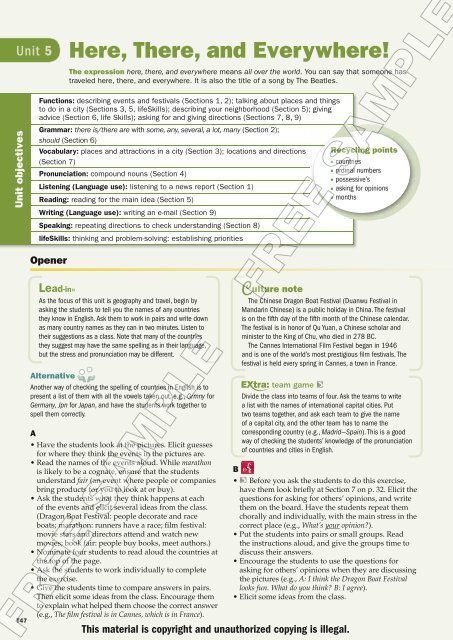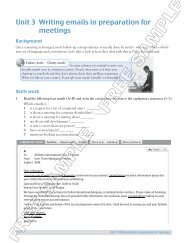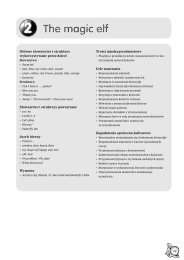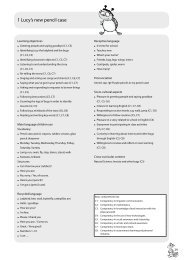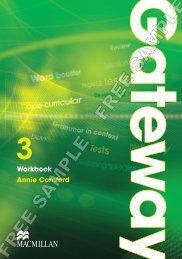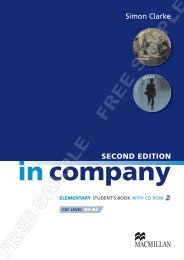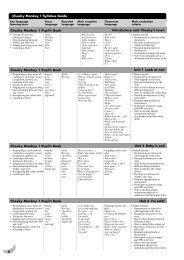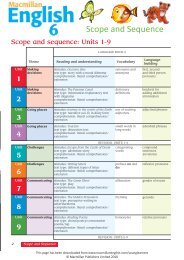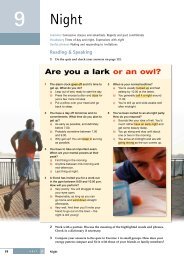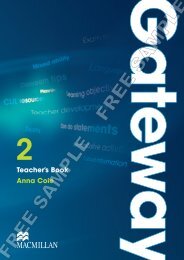there are - Macmillan
there are - Macmillan
there are - Macmillan
Create successful ePaper yourself
Turn your PDF publications into a flip-book with our unique Google optimized e-Paper software.
1248Language use: listening to a news reportAListen to the start of a news report. Circle the correct options.1 Buñol is near the city of ...a) Valencia. b) Murcia.2 La Tomatina festival happens in ...a) September. b) August.BListen to the rest of the report. Circle the correct options.1 Mary speaks to a man from …a) Spain. b) Britain. c) Germany.2 All the people go to … to have breakfast.a) the main squ<strong>are</strong> b) the park c) their houses3 At eleven o’clock, everyone …a) goes home. b) throws tomatoes. c) eats tomatoes.4 The festival continues for …a) two weeks. b) two days. c) two hours.CGive your opinion. What do you think about the Tomatina festival?Do you like festivals in general?Grammar: <strong>there</strong> is/<strong>there</strong> <strong>are</strong> with some, any, several, a lot, manyA Language in context Read about the Caribana festival. Answer the questions.Helen asks “Are <strong>there</strong> any interesting festivals in Canada this year?Is <strong>there</strong> one in eastern Canada? I live in New York.”Jan answers “There is a cool festival in Toronto every year. It’s calledCaribana and it’s all about Caribbean culture. There <strong>are</strong> a lot of visitorsto the city. They all come to dance, eat, and have fun! The carnival paradestarts in the afternoon in the main squ<strong>are</strong>. There’s a big picnic in the parkand <strong>there</strong> <strong>are</strong> several calypso music competitions. There <strong>are</strong> also someother competitions, including a food competition. There <strong>are</strong>n’t manytickets for the festival left. It’s a good idea to buy them soon!”1 Where is the Caribana festival? 2 When does the parade start?Toronto (Canada)in the afternoonB Notice Read the examples from Exercise A in the table. Circle the correct options in thesentences on the next page.AffirmativeNegativeQuestionsThere is a cool festival in Toronto every year.There <strong>are</strong> several calypso music competitions.There <strong>are</strong> also some other competitions.There <strong>are</strong>n’t many tickets for the festival left.Are <strong>there</strong> any interesting festivals in Canada this year?Is <strong>there</strong> one in eastern Canada?This material is copyright and unauthorized copying is illegal.How to say itIt sounds interesting/fun.I love/hate festivals.FREE SAMPLE FREE SAMPLE
1 Language use: listening to a news reportLead-in»Ask the students for examples of famous festivals aroundthe world (e.g., Mardi Gras in New Orleans, Carnival in Rio,etc.) Have the students work in pairs and discuss what festivalstake place in their town, city, or region. Elicit some ideas from theclass, and write the names of some of the festivals on the board.A CD 1, Track 27• Read the instructions aloud. Ask the students if theyhave heard of the festival of La Tomatina. If they haveheard about it, ask them what they know about it.• Ask them to look at the picture and tell you whatthey think the festival is about.Culture noteThe festival of La Tomatina is in honor of Buñol’s patronsaints, St. Louis Bertrand and the M<strong>are</strong> de Deu desDesemparats (Mother of God of the Defenceless), a title forthe Virgin Mary. The tomato fight has been a tradition in thetown since the late 1940s, although no one is sure how itbegan. There <strong>are</strong> theories that it began as a local food fight, oras the result of an overturned truck carrying tomatoes, but themost popular belief is that disgruntled townspeople attackedcity councilors with the vegetables during a celebration.• Give the students time to read the sentences andoptions. Emphasize that they <strong>are</strong> listening for thename of the city and the month when the festivaltakes place.• Remind them not to worry if they don’t understandevery word they hear. Explain that they have workedon listening for specific information in earlier units,and that they should apply this same skill here.• Play the recording once. Ask the students to comp<strong>are</strong>their answers in pairs. Play the recording again, ifnecessary. Check the answers with the class.Audio scriptCD 1, Track 27Reporter: Now, everyone likes a food fight. In the town ofBuñol, they have perhaps the biggest food fight inthe world. Buñol is near Valencia in Spain. They havea tomato festival called La Tomatina. It happens inAugust and everyone in the town throws tomatoes.About 30,000 people enjoy this festival every year.A• Tell the students they <strong>are</strong> going to read about anotherfestival. Ask them to look at the picture of the festival.Ask them what part of the world this could be andwhat might happen at the festival.• Nominate a student to read aloud the two questionsafter the text.• Have the students read the text individually andanswer the questions.B CD 1, Track 28• Tell the students that they will hear a radio interview.The interviewer is named Mary Turner, and sheis in Buñol at the festival. Make sure the studentsunderstand all the vocabulary in the sentences,especially throw.• Give the students time to read through the sentences,and elicit some predictions from the class.• Play the recording once, and have the students justlisten. Then play it again, and have the students marktheir answers.• Ask the students to comp<strong>are</strong> their answers in pairs.Then check the answers with the class.Audio scriptCD 1, Track 28Reporter: We sent our reporter, Mary Turner, to Buñol to learnmore about the festival.Mary: Right now, <strong>there</strong> <strong>are</strong> more than 30,000 people herein Buñol, with people from Britain, Germany, andother countries. That’s because today is the day ofLa Tomatina, the tomato festival. I want to ask localpeople about the festival. … Excuse me.Man: Yes?Mary: I’m from Channel Ten news. Are you from Buñol?Man: Yes. I live here.Mary: What happens in La Tomatina?Man: Well, everyone goes to the main squ<strong>are</strong> and hasbreakfast. At eleven o’clock, everyone starts throwingtomatoes at each other.Mary: And how long does it last?Man: We throw the tomatoes for about two hours. Thewhole town is red at the end!Mary: And why do you do it?Man: I don’t know! It’s just for fun!C• Point out the How to say it box. Elicit additionaladjectives to complete the first sentence and write thestudents’ ideas on the board (e.g., It sounds boring; Itsounds stupid).• Read the instructions aloud. Have a groupdiscussion.• Take a poll to find out what the majority think of thefestival. Find out which students like festivals, andwhich ones they like.2 Grammar: <strong>there</strong> is/<strong>there</strong> <strong>are</strong> with some, any, several, a lot, many• When the students finish the task, check the answerswith the class.B• Have the students look back at the text in Ex. A andunderline all of the examples of <strong>there</strong> is and <strong>there</strong> <strong>are</strong>in the text.• Nominate students to read aloud the examplesentences in the grammar table.FREE SAMPLE FREE SAMPLEThis material is copyright and unauthorized copying is illegal.T48
T49• Give the students time to read the statements, andhave them do the exercise individually.• Have the students comp<strong>are</strong> their answers in pairsbefore you check the answers with the class.• Highlight that the pronunciation of th in <strong>there</strong> is/ð/.Take some time going over the pronunciation,emphasizing that the tongue comes out slightlybetween the front teeth, and the sound is voiced (i.e.,if they touch their throat while making the sound,they can feel their vocal cords vibrating).• Elicit the negative forms (<strong>there</strong> isn’t/<strong>there</strong> <strong>are</strong>n’t) andthe interrogative forms (Is <strong>there</strong>?/Are <strong>there</strong>?).• Highlight that <strong>there</strong> is can be contracted to <strong>there</strong>’s, but<strong>there</strong> <strong>are</strong> does not normally contract.• Ask the students to look at the Watch out! box, andremind them that people is plural, and so follows theplural form.• Nominate students to say the answers, and elicit anexample of each type of sentence from the class.C• Have the students read the statements.• Ask the students to do this exercise individually, andthen to comp<strong>are</strong> their answers in pairs. Encourage thestudents to discuss any differences in their answers.• Check the answers with the class. Remind thestudents that we use any in questions and negatives(#1, #2, and #5), and we never use any in affirmativesentences.3 Vocabulary: places and attractions in a cityA CD 1, Track 29• Ask the students to look at the picture, and elicit thatthe information is about a Chinese New Year festival.• Have the students read the map. Use the icons to helpwith the meanings of unfamiliar vocabulary.• Tell the students they will hear a guide for visitors tothe festival. Explain that they should listen and circlethe places on the map that the speaker mentions.• Play the recording once, and check progress. Play <strong>there</strong>cording again, if necessary. Check the answers withthe class.Audio scriptCD 1, Track 29Hello and welcome to our phone guide for this year’s ChineseNew Year festival. There is a lot for everyone to enjoy. BetweenJanuary 23rd and 28th <strong>there</strong> is a special exhibition of Chinesepaintings at the art gallery on Park Street. There <strong>are</strong> specialevents at the zoo for children under 10 and Chinese dancersand musicians in the central park every day at 11 a.m. Chinesefood is available from special stalls at the shopping mall onweekends. Please note that <strong>there</strong> <strong>are</strong> special buses which leavehourly from …• Ask the students what helped them select the correctform of <strong>there</strong> is/<strong>there</strong> <strong>are</strong> (if the noun is singular use<strong>there</strong> is, and if it is plural use <strong>there</strong> <strong>are</strong>).D• Read the instructions to the class, and nominate twostudents to read the example conversation aloud.• Do another similar example with the class. Choose alocal festival that the students will know—or use oneof the festivals from earlier in this unit—and give abrief description, using <strong>there</strong> is and <strong>there</strong> <strong>are</strong>. Have theclass guess the festival.• Give the students time to think of a festival and makesome notes about what happens during the festival.Remind them to use <strong>there</strong> is and <strong>there</strong> <strong>are</strong>.• Put the students into pairs to complete the task.While pairs work, circulate and check the students<strong>are</strong> using the correct forms of the verb be with <strong>there</strong>.monthsBriefly review the months of the year in English. Have aspelling race. Divide the class into teams of five or sixstudents. Call out one of the months of the year, and haveone person from each team come to the front of the classand write the word on the board. The first team to write theword correctly scores a point. Continue until every member ofthe team has had at least one turn.Workbook p. 28, Section 1B• Read the instructions and the question in #1 aloud.Nominate two students to read themodel conversation.• Put the students into pairs to answer the firstquestion. Encourage the students to use bothaffirmative and negative forms of <strong>there</strong> is/<strong>there</strong> <strong>are</strong>when talking about their town, e.g., There is a park.There <strong>are</strong>n’t any art galleries.• When the students finish, elicit the answers fromthe class.• Read the instructions for #2, and nominate twostudents to read the model conversation.• Ask the students to work in pairs again and listas many other places in their town as possible.Give them time to ask questions about unknownvocabulary. You can expect the students to mentioncognates or loan words, such as bank, supermarket,hotel, and museum.• Write new words on the board, marking the stress,and ask the students to copy the words intotheir notebooks.Workbook p. 28, Section 2FREE SAMPLE FREE SAMPLEThis material is copyright and unauthorized copying is illegal.
4550Pronunciation: compound nounsAListen and repeat. Notice that in compound nouns (noun + noun), the first word is stressed.museum—science museum mall—shopping mall factory—chocolate factory theater—movie theaterBWork in pairs. Make new compound nouns for places in your city. Then practice saying the words.1 history museumReading: reading for the main ideaWhen you read a text, think about these questions. What is the general topic?What is the writer saying about the topic?A Read these texts quickly. Circle the main topic.a) neighborhoods b) festivals c) familiesB Read the texts in Exercise A again. Decide whether each person has a positive or negative opinionof where they live.Emile:positive / negativeMelissa: positive / negativeKostas: positive / negativeCmuseum2 train stationMelissaEmileWork in pairs. Talk about your neighborhood. Do you like it? Why or why not?I like my neighborhood because it’s small and …station3 car factoryfactory”I live in a quiet <strong>are</strong>a in Paris. I like living <strong>there</strong>because it’s very friendly and <strong>there</strong> <strong>are</strong> severalstores and cafés. The only problem is that it’s a littleboring sometimes because <strong>there</strong> <strong>are</strong>n’t any clubs.There’s a good stadium, though. I often go tosports events.””I live in Singapore, in a very busy neighborhood.I don’t like it because it’s noisy and <strong>there</strong>’s lots oftraffic. There’s a shopping mall near my house, andI go <strong>there</strong> a lot. There <strong>are</strong> also museums and a movietheater in the <strong>are</strong>a, but I don’t have time to go tothem. There’s a good food festival in April, though.”Kostas”I live in Oia on the island of Santorini. Myneighborhood is pretty big. A lot of my neighbors <strong>are</strong>members of my family! There <strong>are</strong>n’t many stores,but <strong>there</strong>’s a small art gallery, a movie theater, anda gym. Oh, and <strong>there</strong> <strong>are</strong> a lot of great restaurants.I think it’s a fantastic place to live.”FREE SAMPLE FREE SAMPLEThis material is copyright and unauthorized copying is illegal.
T516 Grammar: shouldLead-in»Elicit some positive things students can do if they want tolearn English well (e.g., speak only English in class, watchEnglish movies, do my homework), and write them on theboard. Introduce the idea of should (a good or positiveaction) and shouldn’t (a bad or negative action). Use theexamples on the board to make sentences with should (e.g.,You should speak only English in class). Then ask them to tellyou things they shouldn’t do if they want to learn English well(e.g., You shouldn’t speak your language in class).A• Have the students look at the three pictures andrepeat the names of the places after you. Ask thestudents to look at the first picture, and elicit themeaning of the word castle. Explain that a departmentstore is a large store, divided into separate sections,where each section sells a different type of item, e.g.,shoes, clothing, kitchenw<strong>are</strong>, jewelry.• Read the instructions aloud, and tell the studentsto look at the three answer options. Check that theyunderstand guidebook (a book for tourists).• Give the students time to read the text and selectthe answer.• When the students finish, check the answer withthe class.• Elicit that the answer is a guidebook, and explain thatin this context, should and shouldn’t <strong>are</strong> used to giveadvice to travelers about what to do on vacation.Culture noteWindsor Castle is the oldest and largest occupied castle inthe world, and is one of the official residences of the Britishmonarch, Queen Elizabeth II.Harrods is one of the world’s largest department stores, ona par with Macy’s, New York. It has over 330 departments.Wembley stadium is located in London and hosts England’shome international soccer matches and other events.B• Focus on the form of the modal verb should.Nominate students to read the example sentences inthe grammar table aloud.• Some learners may have problems producing the shsound in the initial position. If so, ask them to makethe sound shhh for be quiet and to hold the sound foras long as possible. Then add the sounds for differentendings, e.g., –ip (ship), –op (shop), –ould (should).• Have the students work individually to answer thetrue/false questions. Encourage them to refer to thegrammar table to help them find the answers.• Draw the students’ attention to the language box.Highlight the meaning of definitely (certainly, for sure)and its position in the sentence (between should andthe main verb).C CD 1, Track 31• Read the instructions to the class. Give the studentstime to read through the conversation beforethey begin the task. Elicit the general topic of theconversation (planning a trip to London).• Have the students do the exercise individually. Tellthem to use the examples in Ex. A and Ex. B to helpthem complete the exercise.• Ask the students to comp<strong>are</strong> their answers in pairs.Then play the recording to check the answers.Audio scriptCD 1, Track 31Janet: Our trip to London is next week! I’m so excited! Whatshould we do <strong>there</strong>?Max: Well, I have a good guidebook here. It says we shouldsee Windsor Castle, but we shouldn’t visit the castle onthe weekend. We should also visit Wembley Stadium. Weshould probably go on the tour of the stadium.Janet: Good idea! We should definitely go to Harrod’s, too, andwe really shouldn’t miss the food hall. I can’t wait!conversation practicePut the students into pairs, and have them practice theconversation together, changing partners several times.D• Read the instructions aloud, and give the studentstime to think of places they want to recommend. Ifthe students all come from the same town or city, askthem to choose another town or city in their countrythat they know well. Encourage them to make somenotes to help them.• Put the students into pairs, and ask two students toread the model conversation for the class.• Give the pairs time to complete the task, andencourage them to use should and shouldn’t intheir discussion.• Remind the students they can use <strong>there</strong> is/<strong>there</strong> <strong>are</strong> tosay what <strong>there</strong> is to visit in their city, e.g., There’s ascience museum. You should definitely visit it.• When the students finish, nominate a few students tosh<strong>are</strong> their recommendations with the class.homeworkAsk the students to write some advice for tourists visitingtheir country. Encourage them to use should and shouldn’t,and to write at least five tips for things visitors should do andthings they shouldn’t do. You can extend this to a project byhaving the students create a mini-guidebook for visitors withrecommendations for hotels, restaurants, etc., and includingpictures of places around their city.Workbook p. 30, Section 4FREE SAMPLE FREE SAMPLEThis material is copyright and unauthorized copying is illegal.
7 Vocabulary: locations and directions52A Read and match the sentences to the pictures.1 Take the second street on the left.2 Make a U-turn.3 It’s on Laurel Avenue.4 It’s next to the museum.5 Follow the signs for the zoo.6 It’s across from the movie theater.7 Turn left here.A 7E 10 F 4G 11BLook at this street map. Student A, you <strong>are</strong> at the main squ<strong>are</strong>.Student B, you <strong>are</strong> at the art gallery. Ask each other for directionsto different places on the map.A: How do I get to the zoo from here?B: Go right on Main Street. Take the fi rst street on the left.That’s River Street. Then …8 Go over the bridge.9 It’s between the bank and the school.10 Go straight ahead.11 Take the first right.12 It’s on the corner of Mason Street andLaurel Avenue.I 1J 12K 2Lzoomainsqu<strong>are</strong>Main StreetfountainBRiver Street3caféNelson StreetCartgallerymuseumPark AvenueCedar StreetcentralparkDHBaker StreetThis material is copyright and unauthorized copying is illegal.8965How to say itExcuse me, where is the …?How do I get to …?Is <strong>there</strong> a … near here?Turn left/right on ...Lincoln AvenuepolicestationbusstationFREE SAMPLE FREE SAMPLE
7 Vocabulary: locations and directionsLead-in»Check that the students understand the words left and right.Ask questions such as, Who is sitting on Simona’s right?Who is sitting on Damian’s left? This will also give you anopportunity to review possessive ’s.A• Tell the students they <strong>are</strong> going to learn some usefullanguage for getting around a new city.• Read the instructions to the class. Clarify that they <strong>are</strong>matching the sentences to the pictures.• Have the students work individually. Circulate whilethe students <strong>are</strong> working, offering help as needed.• Ask the students to comp<strong>are</strong> answers in pairs,explaining their choices. Then check the answers withthe class.• Highlight that we use expressions like the firststreet on the left, the second street on the right, etc. Brieflyreview some basic ordinal numbers (first, second,third, fourth, fifth).AlternativeHave the students cover the sentences in their student’s book, andtell them to just look at the pictures. Have them work in pairs oras a whole class and try to write the accompanying sentences foreach picture. Then have them uncover the directions in the bookand match them.B• Read the instructions to the class.• Ask the students to look at the How to say it box.Explain that these <strong>are</strong> polite ways of asking fordirections. Have the students repeat the expressions,using words for places and attractions in a city (e.g.,How do I get to the bus station?; Excuse me, where is theart gallery?; Is <strong>there</strong> a bank near here?; Turn left on 7 thAvenue; Turn right on 22 nd Street).• Nominate two students to read the modelconversation aloud.• Highlight that we say, Take the first/second street …,and not *Go the first street …• Put the students into pairs to complete the task.Circulate and monitor while the students<strong>are</strong> working.• When the pairs finish, listen to a few conversationsfrom the class.• Note any errors in the directions, and write them onthe board. Ask the class to correct the mistakes.giving directionsAsk the students to work in pairs and tell each other how toget from the school to their home. If they live a long way fromthe school, they can include instructions like Take bus 47 to …definitions gameDivide the class into two teams. Have one student from eachteam come to the front of the classroom and sit with theirbacks to the board. Write a word on the board behind them.This can either be a word from this lesson, or a word fromearlier in the unit. Nominate one team to describe the word.They must not say the actual word, but can use synonyms,define its meaning, give an opposite, or even give rhymingwords (e.g., it sounds like night; it’s the opposite of left—right). The two students at the front then have to guess theword. The first student who guesses correctly wins the pointfor his or her team. Have the other students on each teamtake turns coming to the front, and alternate which team triesto describe the word.Workbook p. 31, Section 5FREE SAMPLE FREE SAMPLEThis material is copyright and unauthorized copying is illegal.T52
T538 Speaking: repeating directions to check understandingLead-in»Ask the students a simple question about the school, such as:Teacher: Where is the school cafeteria?Students: It’s next to the library.Teacher: Next to the library. OK. Thanks.Tell them that repeating key information like this, and addingOK, is a good way of checking the information.• Nominate a student to read the information in theskills box.• Emphasize that when we repeat information likethis to check we have heard correctly, we often say itslowly to confirm understanding.A CD 1, Track 32• See the student’s book page for the audio script .• Tell the students they <strong>are</strong> going to hear twoconversations. In each conversation, people <strong>are</strong>asking for directions.• Play the recording once, and have the students listenwith their books closed.• Have the students open their books. Read theinstructions to the class.• Play the recording again, and have the studentsunderline the places where the speaker repeatsthe directions.• Check the answers with the class.• Put the students into pairs to practice the twoconversations. Ask them to do this twice, swappingthe roles of A and B, so that they get the maximumexposure to the language in the conversations.9 Language use: writing an e-mailA• Draw the students’ attention to the question, Whatdoes Avril need?• Give the students time to read the text individuallyand look for the answer.• Have the students comp<strong>are</strong> their answers in pairs.Then elicit the answer from the class.AnswerAvril needs directions from the bus station to the artgallery.WorkbookOver to you – p. 32 Down Time – p. 33B• Tell the students they will now practice asking forand giving directions to places in their own townor city.• Read the instructions to the class, and ask twostudents to read the model conversation.• Encourage the students to use Excuse me at thebeginning of their conversation and How do I getto …? to ask for directions.• Put the students into pairs to complete the task.When both students have asked for and givendirections, elicit a few examples from the class.asking for and giving directionsAsk the students to look at the map in Section 7 and choosea starting point and a destination (e.g., from the art galleryto the zoo). Have the students work in pairs and take turnsasking for and giving directions. Encourage them to repeatsome of the directions to check understanding. When thepairs finish, elicit a few examples from the class.Workbook p. 31, Section 6B• Ask the students to look at the How to say it box.Point out that we use Hi in informal e-mails. Theexpression Don’t get lost! is friendly and informal.Encourage the students to use as many of theseexpressions as they can in their e-mail responses.• Circulate and monitor while the students <strong>are</strong> writing,giving help as needed.• When the students finish writing, ask them to sh<strong>are</strong>their e-mails in small groups.AlternativeYou can give the writing task as homework and check it in thenext class.FREE SAMPLE FREE SAMPLEThis material is copyright and unauthorized copying is illegal.
Speaking: repeating directions to check understandingA1BWhen you ask for directions, listen c<strong>are</strong>fully and repeat the essential information to check that you understand.Hi!Listen to the conversations below. Underline the information that Speaker A repeats.A: Excuse me, how do I get to the main squ<strong>are</strong>?B: You take the first right, and go straight ahead.Then turn left on Post Street.A: OK. First right, then left on Post Street.B: That’s right.A: Thank you.B: You’re welcome.Work in pairs. Take turns asking for directions to places in your town.A: Excuse me, how do I get from ... to ...?B: You take the … It’s on ...Language use: writing an e-mailA Read this e-mail from a friend. What does Avril need?Thanks for inviting me to the exhibition. I don’t know where the artgallery is, exactly. I need directions from the bus station to the gallery.How do I get <strong>there</strong>?Thanks a lot!AvrilB Look at the map in Section 7 again.Write an e-mail to Avril giving herdirections in your notebook.How to say itHi, …OK. Here <strong>are</strong> thedirections to ...From …Then …Don’t get lost!See you soon.2A: Excuse me, is <strong>there</strong> a bank near here?B: Yes, <strong>there</strong>’s one on Fort Street.A: Fort Street. OK. And how do I get <strong>there</strong>?B: You go straight ahead, and take the third left.A: Straight ahead, and take the second left.B: No, not the second left, the third left.A: Third left. OK, thanks.FREE SAMPLE FREE SAMPLEThis material is copyright and unauthorized copying is illegal.89Unit 553
Thinking and problem-solving: establishing prioritiesThe lifeSkills section has a two-tiered design which includes a linguistic focus and a soft skills focus.The aim of the first is to recycle and consolidate the target language of the unit, and the aim of thesecond is to expose the students to vital soft skills that will enable them to become more competitiveand successful in their academic and professional lives.When you teach the lifeSkills section, you may decide to draw attention to the bulleted steps atthe start of the section which break down the soft skill. It is important to remember that the skillsdeveloped in this section can be applied in contexts beyond the English classroom. However, if youprefer to teach the section without discussing the underlying soft skill, this is also possible. Thesection is designed to be engaging and successful either way.Thinking and problem-solving: establishing prioritiesStep 1 Understand the criteria. (Ex. A)Step 2 List the options. (Ex. B, Ex. C)Step 3 Order the options according to the criteria. (Ex. D, Ex. E)The following <strong>are</strong> some ideas for how to highlight the soft skill. You may choose to do one or several ofthese at the beginning of the lesson, at the end, or as you go through the exercises in the section. Yourapproach to the lifeSkills section may vary depending on your class and the unit.• Read the target skill aloud and highlight the three-step strategy to develop the skill. Check that thestudents understand all the vocabulary.• Relate each exercise in the lifeSkills section to the relevant stage in the three-step strategy beforeyou ask the students to begin the exercise (e.g., The aim of this exercise is to understand criteria. Thisis Step 1 in the three-step strategy.).• When the students finish all the exercises, ask them to read the Reflect statement. Encourage themto tell you what they have learned or practiced in this section, and where and how they can apply thestrategies outside the classroom. Emphasize the steps they’ve explored and practiced.• Tell the students that this section of the unit willhelp them with organizing information byestablishing priorities.• Ask the students when they need to prioritize (putthings in order of importance) in their lives. Elicit oneor two ideas from them. Possible answers includeWhen we have a lot of homework, but we also want to goout with friends, and so on.A• Read the instructions to the class, and ask thestudents to read the two questions. Make sure theyunderstand the meaning of spend (use money to payfor things).• Have the students read the text and try to find theanswers to the questions as quickly as possible.Check the answers with the class.• Emphasize that this e-mail has helped the studentsunderstand the criteria in the process of establishingpriorities: Danny is in the city for one day and has$40 to spend.B• Before you ask the students to work in pairs anddiscuss the questions, tell them to look at theexpressions in the How to say it box. Check that theyunderstand the meaning of free (you don’t payanything for something that is free).• Make sure the students <strong>are</strong> familiar with the localvalue of $40. If you <strong>are</strong> not sure, check in thenewspaper or on the Internet.• Put the students into pairs to complete the task.Circulate while the students <strong>are</strong> working, and offerhelp with ideas as needed.• Explain that this is the second important step whenestablishing criteria. After we have understood thecriteria, we list the available options.it’s freeHave the class brainstorm a list of interesting things touristscan do for free in their city.FREE SAMPLE FREE SAMPLEThis material is copyright and unauthorized copying is illegal.T54
T55C• Ask the students to work in the same pairs. Askthem to look at their list of attractions from Ex. B anddecide on the five most suitable ones. Remind themthat they have to conform to Danny’s criteria (moneyand time).• When the students finish, ask them to rank the fiveattractions they have chosen in order of importancefrom 1 (most suitable) to 5 (least suitable). Emphasizethat ordering the options according to Danny’scriteria is the last important step whenestablishing priorities.D• Give the students time to write their responses. Thisexercise can either be done individually or in pairs asa collaborative writing task.• Encourage the students to try to use all fivesuggestions from Ex. C and to write the reasons,too. Circulate and monitor while the students <strong>are</strong>working. Give help where needed, and point out anygrammatical errors in their writing, especially in theuse of should (e.g., inserting to between should and themain verb).E• Put the students into groups of four or five.• Have the students sh<strong>are</strong> their responses to Dannywith their group and decide which ones make thebest use of his budget and time.• Nominate a few students to read their options tothe class.Reflect• Give the students time to read the Reflect statement• Encourage them to give you examples of situations intheir lives where they need to establish priorities.• Elicit the process the students used to develop anddecide on their recommendations for Danny.• Remind the students that the ability to prioritize canhelp them to organize their time when they have a lotof things to do.FREE SAMPLE FREE SAMPLEThis material is copyright and unauthorized copying is illegal.
CThink about organizing your options from Exercise B. Complete thisTop 5 Things to Do! list for Danny with your partner. Decide why youthink Danny should see or do these things. Remember that he onlyhas $40 and 13 hours in your town/city.Gregg’s chocolate factory tourReason: It’s cheap (only $12) and interestingD Write a short response to Danny.EPosted on:May 4 at 14:21Registered:07/23/09Posts: 12Re: Where to go? Help!Hello, Danny1992! There <strong>are</strong> lots of great things to do in my city.You should defi nitelyYou should probablyYou should reallyEnjoy your stay!Read your options to your classmates.Decide which ones make the best use ofDanny’s $40 budget and time.{ }Reflect...In what other situationsdo you need to establishpriorities?FREE SAMPLE FREE SAMPLEThis material is copyright and unauthorized copying is illegal.Unit 555
1256Language Wrap-upVocabularyA Look at this map. Complete the place names with words from the box. (4 points)gallerystationmalltheaterB Look at the map in Exercise A again and complete the sentences. (6 points)1 You <strong>are</strong> at the bus station 1st Street. Take the second right, go the bridge, andturn left. Go straight ahead and the is in the park, the café.2 You <strong>are</strong> in the main squ<strong>are</strong>. Turn right and go straight ahead. Then take the third left.The is on the right the bank.8–10 correct: I can talk about places and attractions in a city and ask for and give directions.0–7 correct: Look again at Sections 3 and 7 on pages 49 and 52. SCORE: /10GrammarartmovieRead these contributions to a chat room. Circle the correct options. (10 points)In Granada, <strong>there</strong> (1) is / <strong>are</strong> a fantastic Moorish monument—the Alhambra Palace. You (2) should /shouldn’t visit in April or May. It’s nice, but not too hot. The food in Spain is excellent and <strong>there</strong> (3) is / <strong>are</strong> a lotof restaurants. But you (4) should / shouldn’t eat in restaurants near the Alhambra—they <strong>are</strong> very expensive.Antigua is a beautiful city. There (5) is / <strong>are</strong> several pretty squ<strong>are</strong>s where you can have lunch or just drinkcoffee. If possible, you should (6) fi n d / go a hotel in the main squ<strong>are</strong>. You (7) should / shouldn’t travel in taxis inAntigua because it’s small, and it’s possible to walk everywhere.Ko Samui is a fantastic island. There (8) isn’t / <strong>are</strong>n’t many cars and you can relax completely.The restaurants and cafés <strong>are</strong> very friendly and <strong>there</strong> (9) is / isn’t a lot of good food. Sometimes <strong>there</strong>(10) is / <strong>are</strong> traditional dances.fountainPark Street1st Streetbusstationmainsqu<strong>are</strong>8–10 correct: I can use <strong>there</strong> is, <strong>there</strong> <strong>are</strong>, and should to talk about places and to give advice.0–7 correct: Look again at Sections 2 and 6 on pages 48 and 51. SCORE: /10parkMain Streetcafesciencemuseum2nd StreetshoppingFREE SAMPLE FREE SAMPLEThis material is copyright and unauthorized copying is illegal.3rd Streetbank4th Streetpolice
Language Wrap-upStudents can do the Language Wrap-up exercises in class or for homework. If you give them forhomework, remember to check the exercises at the beginning of the next class or collect a few to markand identify any typical errors.If you decide to do the exercises in class, you can approach the Wrap-up as a two-step reviewingprocedure. First, ask the students to do the Vocabulary section individually. When ready, encouragethe students to check their answers c<strong>are</strong>fully and then put them in pairs to comp<strong>are</strong> answers anddiscuss any differences. Self- and peer-correction <strong>are</strong> two excellent ways of developing your studentsas independent learners and for creating a cooperative learning environment. After completing theVocabulary section, you can apply the same procedure to the Grammar section.At the end of each section, ensure the students write their score out of 10. If they have a score lowerthan 8, direct them to the appropriate sections of the unit and encourage them to read them again forhomework. After that, ask the students to complete the exercise(s) again at home.1 VocabularyAAnswersart gallery, movie theater, shopping mall, policestation2 GrammarCulture noteThe Alhambra, built in the 14 th Century, is a palace and fortress in Granada, Spain.The palace was once the residence of the Muslim rulers of Granada. Today, the Alhambrais one of Spain’s major tourist attractions and shows the country’s most famous Islamicarchitecture.Antigua is a city in central Guatemala. It is known for its beautiful Spanisharchitecture, as well as the well-preserved ruins of several colonial churches.Ko Samui is a tropical island in the south of Thailand. It is Thailand’s third largestisland, and it is known for its beautiful beaches and coral reefs.Common European Framework: unit mapUnit 5 Competence developed CEF Reference (A1)1 Language use can understand information in a news report Table 1; Table 2; Section 4.4.2.12 Grammar can use and understand <strong>there</strong> is/<strong>there</strong> <strong>are</strong>3 Vocabulary can describe places/attractions in a city4 Pronunciation can correctly stress compound nouns Section 5.2.1.4Table 1; Table 2; Section 4.4.1.1;Section 5.2.1.2Table 1; Table 2; Section 4.4.1.1;Section 4.4.3.1; Section 5.2.1.15 Reading can identify the main topic in a text Table 2; Section 4.4.2.26 Grammar can use and understand should7 Vocabulary can give and understand directions8 Speaking can ask for directions9 Language use can respond to and write a short e-mail10 lifeSkills can work with others to establish prioritiesBAnswers1 on, over, science museum, next to2 police station, across fromAnswers1 is 2 should 3 <strong>are</strong>4 shouldn’t 5 <strong>are</strong> 6 find7 shouldn’t 8 <strong>are</strong>n’t9 is 10 <strong>are</strong>Table 1; Table 2; Section 4.4.1.1;Section 5.2.1.2Table 1; Table 2; Section 4.4.3.1;Section 5.2.1.1Table 1; Table 2; Section 4.4.3.1;Section 5.2.3.2Table 2; Section 4.4.1.2; Section 4.4.3.4;Section 5.2.1.6FREE SAMPLE FREE SAMPLEThis material is copyright and unauthorized copying is illegal.T56


